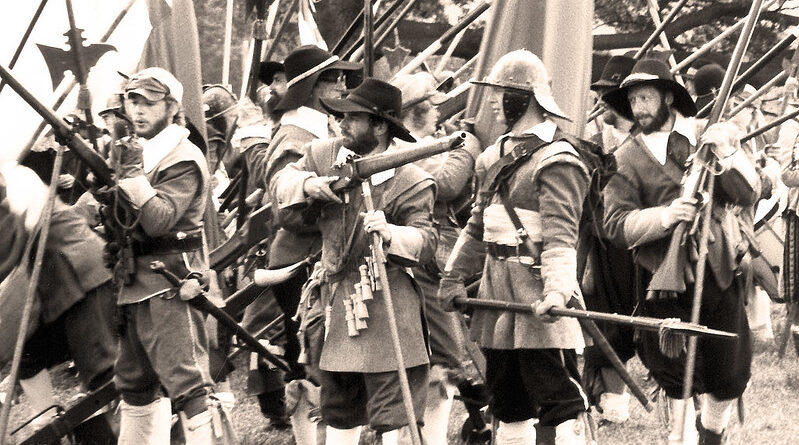The English Civil War
One of the most important and violent periods in British history, the English Civil War was a series of closely related conflicts during the 17th Century, which saw the monarchy deposed and abolished for the first time in history. Replaced by the Commonwealth, under the leadership of Oliver Cromwell, the republican period was relatively short-lived, but nonetheless proved to be a major turning point in the monarchy’s history.
What Caused The War?
There were numerous different causes for the eruption of tensions in the English Civil War, ranging from long-gestating institutional reasons as well as the more immediate actions of the King Charles I.
Tensions had begun to emerge between the King and Parliament during the reign of Charles I’s father James I. James I, having acceded the throne following the death of Elizabeth I, oversaw the unification of the English and Scottish Kingdoms, having held the latter position initially. The Scottish Parliament was comparatively weak and submissive to the King’s demands, something which James I expected of the English Parliament following his accession to the throne. He led a lavish and indulgent lifestyle, which created tensions between himself in the Parliament, whilst leaving its financial resources depleted. Furthermore, his belief in the divine right of the King left him ignorant to the concerns of Parliament. However, he had a notably even-tempered and peaceful manner, which prevented tensions from erupting during his reign.
The financial strains placed on parliament by the monarchy only escalated during the reign of Charles I, who shared a similar patronising disdain towards parliament to his father. Charles I led a similar lifestyle of excess, and is known today for his patronage of the arts, which placed a substantial financial cost on Parliament. Regularly running out of funds to keep up with his lifestyle, Charles I attempted to forcibly tax his subjects in order to generate sufficient capital. These intensified tensions significantly, with Charles I’s pig-headed disposition further fuelling hostilities towards him. Charles I’s disdain towards parliament saw him not call upon it for a decade in a period which is known as the ‘personal rule of Charles I’. His personal traits exasperated the long-gestating political tensions between monarchy and parliament.
A significant, inter-related issue, which helped trigger the Civil War was religious discord. Specifically, conflict between Protestantism and Roman Catholicism had been raging throughout the continent for over a century. There was a deep-seated animosity towards Roman Catholics within England in light of recent conflicts such as the Thirty-Years War, the Gunpowder Plot and most significantly the Spanish Armada. Charles I’s marriage to Henrietta Maria of France, a practicing Roman Catholic did little to endear him to the Protestant Parliament. Charles I himself, much like his father, believed in the ‘Divine Right of Kings’ and practiced a lavish form of Anglicanism, which alienated Protestants significantly, who felt he was being corrupted by Catholicism. His religious fanaticism backfired significantly when he attempted to impose his positions upon his Scottish subjects, which led to the First Bishops’ War, one of the most embarrassing military defeats in English history, which saw him abandon this proposition.
This diverse combination of factors had undermined any faith in Charles I and to a greater extent, the monarchy itself. Tensions reached a boiling point in 1642 as civil warfare finally broke out.
Charles I
One of the most notorious monarchs of all time, Charles I ruled for a tumultuous 25 years and is famously known as the only British King to be successfully deposed and executed. Charles I’s reign was defined by conflict. Throughout his reign, he quarrelled incessantly with the Parliament over a number of issues. He had inherited his father’s love for opulence as well as his religious fanatacism, which alienated him from the Protestants around him during a sensitive time of conflict with Roman Catholicism. His unwavering belief in the divine right of Kings saw him come into repeated conflict with Parliament, while his inefficient policies enacted to support his lavish lifestyle caused significant resentment and opposition towards him develop. A tyrannical figure ignorant to the changing landscape around him, Charles I remains one of the most significant monarchs in British history. His rule coincided with one of the biggest periods of upheaval in the country’s history.
Oliver Cromwell
Battle of Naseby, 14 June 1645. The victory at Naseby of the Parliamentarian New Model Army under Fairfax and Cromwell over the Royalist army commanded by Prince Rupert marked the decisive turning point in the English Civil War. (Photo by Ann Ronan Pictures/Print Collector/Getty Images)
The other most significant figure in the English Civil War was Oliver Cromwell, who remains one of the most divisive figures in the country’s history. Cromwell’s early life is shrouded in mystery but he emerged as a major player during the English Civil War on the side of the Parliamentarians, demonstrating clear skill as a military commander. He quickly rose up the ranks and was instrumental to the defeat of the royalists. Following the execution of Charles I, Cromwell was the head of the Commonwealth of England under the title of Protector. His subsequent reign was incredibly polarising, with some dubbing him a liberator while most critical of his genocidal tendencies.
Cavaliers Vs. Roundheads
In simple terms, the English Civil War was a conflict between Royalist and Parliamentary forces. The Royalists, as the name suggests were those loyal to Charles I and were dubbed ‘Cavaliers’, an initially derisive term created by their opponents which they later adopted. The Parliamentarians were nicknamed the ‘Roundheads’ again an initially derisive nickname which was later embraced. These two forces came into conflict over a number of reasons, but the main cause was the division over how the country was to be run. The Cavaliers supported the absolute monarchy proposed by Charles I whilst the Roundheads supported a reformation and a more balanced distribution of power between the Crown and parliament.
Oxford: The Royal Capital
With tensions rising and battle lines drawn, Charles I and his supporters found themselves ousted from their home of London and forced into establishing a new base elsewhere. In 1642, Oxford became the new home for Charles I’s Court, serving as the main Royalist base of support throughout the Civil War.
The Main Battles
There were a number of critical battles during the English Civil War, however, three in particular defined the narrative of the conflict.
The Battle Of Edgehill – 23 October 1642
This was the Civil War’s first significant military battle. Taking place in Southern Warwickshire, the battle marked a major escalation in tensions following the breakdown of relations between the King and Parliament earlier in the year. In the intervening months, both the Cavaliers and the Roundheads spent time amassing military support. Charles I, known for his belligerence, decided to force a direct confrontation with his foes and marched towards London. The Roundheads, lead by the Earl of Essex, assembled to prevent the King’s advance. The conflict was known for the poor organisation and experience of troops on both sides, and both forces underestimated the distance between one another. The battle ultimately proved to be inconclusive, with the King unable to force his way through the Earl’s army. This battle is seen as key in elongating the conflict, preventing both the Royalists and the Parliamentarians from gaining an early advantage.
The Battle Of Marston Moor -2 July 1644
The most famous battle during the English Civil War, the Battle of Marston Moor was a major turning point in the conflict. Taking place in England’s North near York, a Royalist stronghold, the battle saw the conflict sway in favour of the Roundheads. The combined Parliamentarian and Scottish forces exceeded those of Charles’ Royalists. Despite Prince Rupert of the Rhine, a brilliant military figure leading the Royalist forces, they found themselves outmanoeuvred . Despite securing early gains, the Royalists grew complacent and left themselves vulnerable to a surprise attack lead by none other than Oliver Cromwell. The defeat destroyed Prince Rupert’s reputation but more importantly saw York fall to the Parliamentarians, effectively ending Charles’ control over Northern England. Furthermore, the success strengthened Cromwell’s reputation, solidifying his status as a major Parliamentary leader and paving the way to his future as leader of the Commonwealth.
 Battle Of Naseby – 14 June 1645
Battle Of Naseby – 14 June 1645
Considered to be the most important and decisive battle of the Civil War, the Battle of Naseby effectively sealed Parliamentary victory. Taking place in a village in Northampton, the battle began as the Parliamentarian New Model Army, led by Sir Thomas Fairfax stormed Oxford, the base of the Royalists, while King Charles engaged them directly instead of retreating. This decision proved to be a significant and costly miscalculation. The tactical nous of Cromwell and Fairfax once again outmanoeuvred the Royalists, inflicting devastating losses and a fatal loss of morale upon them. The Battle had essentially left the Royalists depleted of men and resources and tipped the scales of the conflict decisively in favour of the Parliamentarians. Within a year, the First English Civil War had ended.
Defeat For The King
Following the Battle of Naseby, Charles I was left in an especially vulnerable position. His armies and vital resources had been depleted to a significant degree. Although he attempted to reignite his campaign against the Parliamentarians by galvanising his support base in the Midlands, he still did not have sufficient resources. He was handed over to the Parliamentarians, escaping in 1646, after which he allied himself with the Scottish, only for this to fall through as they handed him over to the Parliamentarians after striking a deal.
The Second Civil War soon broke out whilst Charles was in captivity as divisions emerged within the Parliamentarians which he exploited to his advantage. He managed to convince the Scottish to back a Royalist plot against the Parliamentarians, and they invaded England while a number of scattered uprisings emerged across the country. All of these were quashed by the Parliamentarian New Model Army, which ended any chance of a decisive Royalist victory. Imprisoned and defeated, Charles awaited trial.
The Trial
Always casting a deluded figure, Charles I still believed he had wriggle room to negotiate his way back into power, but his more radical opponents such as Cromwell had other ideas. He was accused of high treason, with his prosecutors citing his misuse of power to benefit himself over the country. The war had seen 300,000 people die, which was laid upon Charles. Charles I, refused to accept the validity of the trial, continuing to believe in hid divine right. He was found guilty of all charges and sentenced to death.
The Execution
Charles I’s execution was a more sombre affair than a celebratory one. After bidding farewell to his younger children Elizabeth and Henry, he was executed on 30 January 1649 at the Palace of Whitehall. He was beheaded in one stroke by an executioner whose identity remains a mystery to this day. His head was sewn back to his body and he was privately buried in Windsor.
Art Sale Of The Century
Known for his extravagant lifestyle, Charles I was a major patron of the arts and known for an immense collection of art, considered by contemporary standards to be one of the most valuable and extensive in existence. Due to the major financial strains placed on the country’s economy by Charles I, which were exacerbated during the war, these works were sold off under Oliver Cromwell’s orders as a means of raising capital. The paintings were dispersed throughout the world and were only reunited under a single exhibition very recently in 2018.
The Puritan Rule Of Cromwell
Having played a major role in the Parliamentarians’ success over the Royalists, Oliver Cromwell eventually rose to the status of Protector of the Commonwealth, an Republican institution established in the absence of the Crown. Immediately after Charles I’s execution, the Commonwealth was ruled by a Council, while Cromwell oversaw the end of the Irish Confederate Wars, a hugely controversial chapter of his life which saw him lead an effort to extinguish a coalition of Irish Roman Catholics and Royalists. The conflict saw hundreds of thousands of Catholics dead while Ireland fell under England’s control. Cromwell oversaw a series of Penal Laws enacted against Roman Catholics in the Commonwealth, a major part of his Puritanical rule.
Eventually, he was appointed Protector of the Commonwealth by his fellow leaders inn 1653 and he remained a proactive leader, aggressively enacting Puritanical policies at home and abroad. In the American colonies, he oversaw his subjects’ submission to the Puritans. Despite being a polarising figure, he had the firm backing of Parliament, who even offered him the Crown, which he eventually refused.
Cromwell’s rule was known for being highly austere, informed by the Puritanical Christian values of himself and his supporters. Policies included the banning of Christmas celebrations amongst many other bizarre rules.
Cromwell died of natural causes in 1658. His funeral was ironically as lavish as his royal predecessors who he so adamantly opposed. He was succeeded by his son Richard, which lead to the final phase of the English Civil War
The End Of The Commonwealth
Richard’s succession of his father was met with immediate controversy. It would be an exaggeration to describe him as incompetent but it was clear he lacked the leadership qualities of his father. Critically, he lacked the essential support of the New Model Army, who ousted him from power after a mere seven months. In his place, the Rump Parliament returned to power under the leadership of Charles Fleetwood.
Internal conflicts plagued the Rump Parliament, as Fleetwood and John Lambert sought to suppress it and claim power as the Committee of Safety. They lacked public support, which hindered these efforts. They had alienated Republicans and Presbyterians and most critically, the military. The power vacuum had left the country in a state of escalating instability.
George Monck, a major General during the Civil War, lead a renewed Parliamentary effort to restore the monarchy, seeing it as the only way to restore stability to the government. A confrontation loomed between Monck’s forces and the Committee of Safety, but the latter fell apart entirely.
Eventually, Charles II, Charles I’s exiled son, returned to the throne in 1660, thus beginning the Restoration.
The Restoration
Following Charles II’s accession to the throne, a period known as the Restoration began. He consolidated control over the English, Irish and Scottish monarchies while a major cultural and political change occurred across the country.
The Restoration is known for a period of cultural renewal, relaxing a number of hardline Puritanical policies enacted under Cromwell’s rule. The period was known for reviving the flagging arts of literature and theatre. Charles II was known as a less absolutist leader than his father and agreed to concessions regarding religious tolerance. He also oversaw the reintroduction of a political cabinet. He enjoyed considerable popular support upon his coronation.
Domestically, he enjoyed many successes, and continued to expand Britain’s overseas empire. He enjoyed success in this regard despite incurring major losses in the Anglo-Dutch War.
Overall, Charles II was considered to be one of Britain’s most successful monarchs, stabilising the Crown and the country after many years of change and uncertainty. The Reformation set the country on a path of development for years to come.
Revenge: What Happened To Cromwell’s Head?
Although Oliver Cromwell died by natural causes and remained in power at the time of his death, his corpse did not enjoy the same pleasantries. Having been buried in Westminster Abbey following a lavish ceremony, his body was dug up after Charles II assumed the throne, on Parliament’s orders. Following this, his body was posthumously executed, publicly hanging for a day. The corpse was then decapitated and placed on a spike where it remained for decades.
The head was struck by lightning, falling off its spike and regularly switched hands between a number of wealthy private collectors. Eventually, it was found in the 20th Century and buried at the University of Cambridge.
The head is a major political symbol, initially functioning as an ominous warning to those who thought of again usurping the monarchy. Some dismiss its authenticity, and this issue has promoted endless debate over centuries.
Daily Life In Puritan England
One of the main beliefs of the Puritans was that if you worked hard, you would get to Heaven. Pointless enjoyment was frowned upon. Cromwell shut many inns and the theatres were all closed down. Most sports were banned. Boys caught playing football on a Sunday could be whipped as a punishment. Swearing was punished by a fine, though those who kept swearing could be sent to prison.
Sunday became a very special day under he Puritans. Most forms of work were banned. Women caught doing unnecessary work on the Holy Day could be put in the stocks. Simply going for a Sunday walk (unless it was to church) could lead to a hefty fine.
To keep the population’s mind on religion, instead of having feast days to celebrate the saints (as had been common in Medieval England), one day in every month was a fast day – you did not eat all day.
Cromwell divided up England into 11 areas; each one was governed by a major-general who was trusted by Cromwell. Most of these generals had been in Cromwell’s New Model Army. The law – essentially Cromwell’s law – was enforced by the use of soldiers.
Cromwell believed that women and girls should dress in a proper manner. Make-up was banned. Puritan leaders and soldiers would roam the streets of towns and scrub off any make-up found on unsuspecting women. Too colourful dresses were banned. A Puritan lady wore a long black dress that covered her almost from neck to toes. She wore a white apron and her hair was bunched up behind a white head-dress. Puritan men wore black clothes and short hair.
Cromwell banned Christmas as people would have known it then. By the C17th, Christmas had become a holiday of celebration and enjoyment – especially after the problems caused by the civil war. Cromwell wanted it returned to a religious celebration where people thought about the birth of Jesus rather than ate and drank too much. In London, soldiers were ordered to go round the streets and take, by force if necessary, food being cooked for a Christmas celebration. The smell of a goose being cooked could bring trouble. Traditional Christmas decorations like holly were banned.
Cromwell And The Irish
Despite being a highly religious man, Cromwell had a hatred for the Irish Catholics. He believed that they were all potential traitors willing to help any Catholic nation that wanted to attack England.
He used terror to ‘tame’ the Irish. He sent an army there and despite promising to treat well those who surrendered to him, he slaughtered the people of Wexford and Drogheda who did surrender to his forces. He ordered that all Irish children should be sent to the West Indies to work as slave labourers in the sugar plantations. He knew many would die out there – but dead children could not grow into adults and have more children. Cromwell left a dark stain on the history of Ireland.





